Conversion of Muscle to Meat
Objectives:
(1) To discuss factors related to the conversion of muscle to meat.
(2) To describe the events that occur during rigor mortis formation.
(3) To show what happens when stress — either long-term or short-term — depletes glycogen prior to death.
Reading material: Principles of Meat Science (5th Edition), chapter 5, pages 97 to 122. The remaining portions of this chapter will be covered under the meat tenderness and meat tenderization sections of the course.
Homeostasis — Maintenance of a physiologically balanced internal environment. This includes pH, temperature, oxygen concentration, and energy supply. In the living animal, this is an important process that is activated quickly after death.
Immobilization and Exsanguination — Immobilization is where the animal is rendered unconscious prior to bleeding and exsanguination is where blood is removed from the animal.
Postmortem pH decline — Postmortem pH decline has a tremendous impact on the color of meat — whether normal, dark or light. The following describes some of the problems associated with meat if animals are stressed prior to slaughter:
Muscle pH problems
In living muscle, energy is stored as glycogen: glycogen to glucose to pyruvate

In dying muscle, lactic acid accumulates and lowers pH.
Within 24 hours after death
(1) glycogen ——-> lactic acid
(2) muscle pH: 7.0 ——-> 5.6 (because of lactic acid)
(3) muscle color: purple changes to bright red or pink (pH 7.0 ——-> 5.6)
pH also is important in determining the water-holding capacity of meat, the ability of meat to retain its water during application of external forces such as cutting, heating, grinding, or pressing. There are three locations of water found in meat:
- Bound (charged hydrophilic groups on the muscle proteins attract water, forming a tightly bound layer)
- Immobilized (has less orderly molecular orientation toward the charged group),
- Free (held only by capillary forces, and their orientation is independent of the charged group).
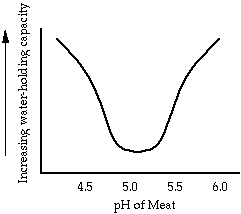
The following graph depicts the relationship between pH and water-holding capacity. Where water-holding capacity is the lowest is the isoelectric point, where the number of positively and negatively charged groups of the myofibrillar proteins is equal. Thus, the charges cancel out and no charge is available to hold the bound and immobilized water.
Dark, firm and dry pork (DFD)
Long-term glycogen depletion (environmental)
Cause: Extended transport-hauling of pigs, without feeding, depletes muscle glycogen. Limited lactic acid production occurs postmortem
Solution: Feed and rest for 24 or 48 hr prior to slaughter.
Dark cutting beef or lamb
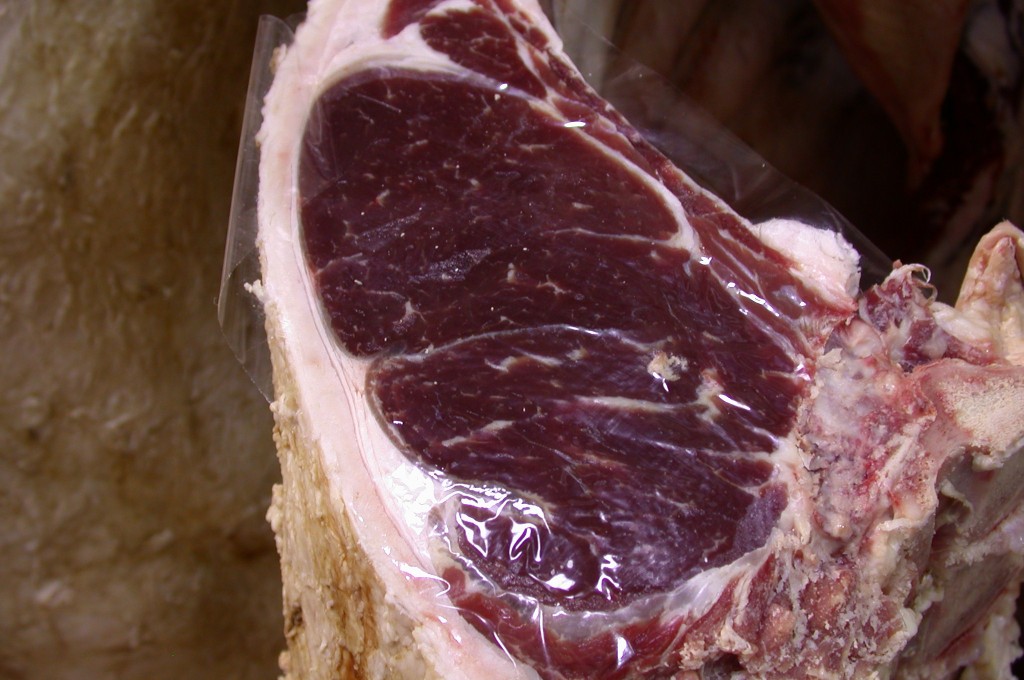
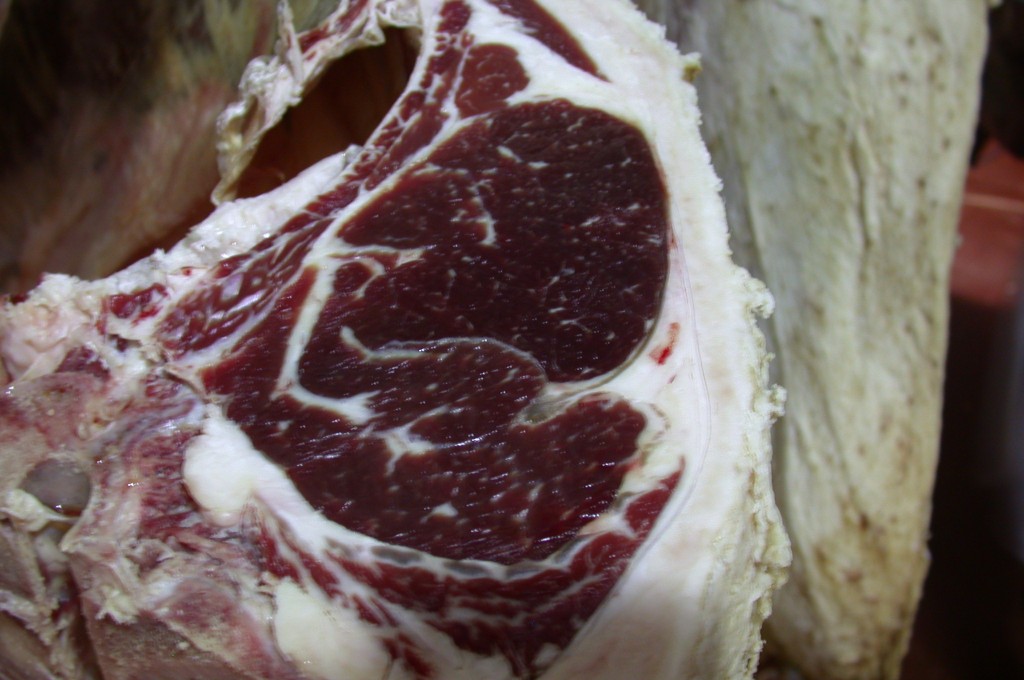
Long-term glycogen or intermediate glycogen depletion (environmental and hereditary). See dark cutting post for more details and photos.
Cause: Beef Stress Syndrome, “Alarm” reaction of General Adaptation Syndrome
Fright = “fight or flight”

Glycogen concentration goes down.
Factors involved in this: exhaustion, exposure to cold, excitement, sex (bullock), sudden feed withdrawal, sickness, show steer.
Solution: Proper handling and prevention of stress best way to reduce incidence.
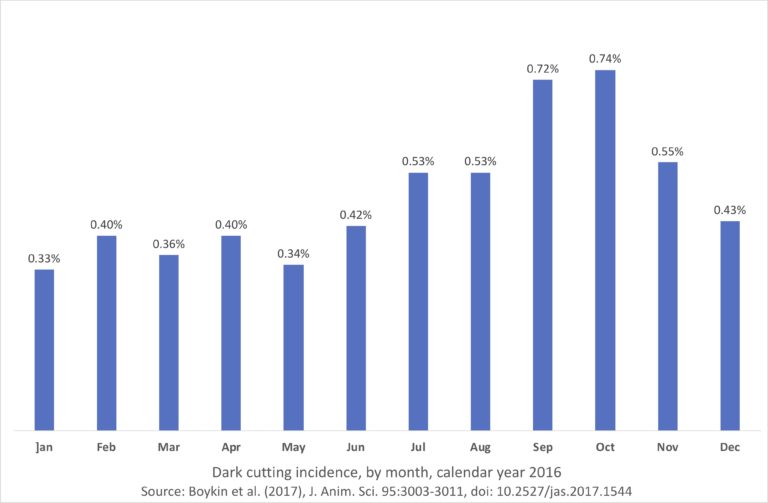
Dark cutting incidence, by month, 2016
Pale, soft and exudative pork (PSE)
Short-term glycogen depletion (hereditary)
Cause: Hereditary: (1) swine susceptible to PSS (disease), and (2) swine susceptible to PSE (reaction to excitement or slow chilling).
PSE pork — short-term glycogen depletion prior to death. Very rapid glycolysis due to excitement (antemortem) or due to holding on kill floor a long time before chilling (postmortem). pH reaches 5.2 in 2 hr postmortem.
Loss of color, firmness, water-holding capacity.
Solution: Decrease emphasis on selection for heavy muscle (highly related to degree of muscle). Now selecting for looser frames, less muscle expression.
Muscle color, glycogen content, lactate production, and pH decline
| Muscle color | Glycogen at death | Glycogen at 24 hours postmortem | Lactate production | Ultimate pH |
|---|---|---|---|---|
| Normal | 1.0% | 0.1% | High | 5.6 |
| Dark | 0.3% | 0.1% | Low | 6.0 to 6.5 |
| Pale | 0.6% | 0.1% | Very high | 5.2 |
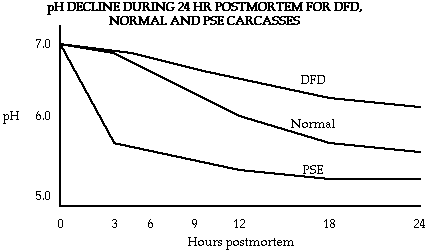
Rigor mortis
Literal translation is “death stiffening.” Rigor has four phases:
Delay phase — while there is plenty of ATP in the muscle (complexed with Mg++), the muscle will remain in the relaxed state and no crossbridges between the thick and thin myofilaments will occur.
Onset phase — As stores of ATP and Creatine Phosphate (CP is used to rephosphoryate ADP to ATP) are used up, rigor bonds between the thick and thin myofilaments are formed. As more bonds are formed, the muscle loses extensibility.
Completion — When all of the CP is gone, the muscle has no way of regenerating ATP. Thus, full rigor mortis will set in.
Resolution — The action of proteolytic enzymes will cause the muscle to soften through protein degradation during postmortem aging.
Review of material — What the student should know:
(1) What homeostasis is.
(2) The impact of postmortem pH decline on muscle color.
(3) What are the problems associated with long-term or short-term stress.
(4) What are the three different phases of rigor and what the roles of ATP and CP are in prolonging the delay and onset phases.
Links to related sites
Rigor mortis. Beef Quality Research on behalf of The Beef Checkoff, National Cattlemen’s Beef Association. Prepared by Center for Meat Safety and Quality, Department of Animal Sciences, Colorado State University.
